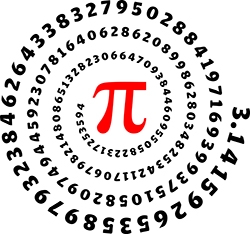March 14 is a big day for the mathematically inclined, not only because it is the birthday of the consummate mathematician Albert Einstein, but also because it’s a worldwide celebration of the concept of pi (π).

Pi is the most recognized mathematical constant in the world. Many scholars consider pi the most important and intriguing number in all of mathematics. Beyond the confines of academia, pi is vital to calculations in physics, engineering, electronics, navigation, and a host of other applications. It is the mathematical constant that expresses the ratio of a circle’s circumference to its diameter. Numerically, March 14 is 3/14, the first three digits in the value of pi.
This year’s “Pi Day,” as March 14 is called, is particularly noteworthy. Appending the digits 15 for the year and 9:26:53 (a.m. or p.m.) for the time of day results in a value equivalent to the first 10 digits of pi.
The ratio is a “constant,” unchanging regardless of the size of the circle, and the number has been calculated to more than 1 trillion digits past its decimal, continuing infinitely.
“You can also express pi in terms of a circle’s area and radius, but then it’s the ratio of the area to the square of the radius,” says Peter Winkler, the William Morrill Professor of Mathematics and Computer Science.
“Mathematicians have observed that the digits of pi seem to behave as if they were random, but no one has managed to prove that they really do,” says Winkler.
The ancient Babylonians, as early as 1900 B.C., provided the first documentary evidence of pi in calculating the area of a circle. The calculations were refined by Archimedes in the 3rd century B.C., and subsequently labeled with the Greek letter π by 18th-century mathematicians.
But not everyone is enthralled.
“Some of us refuse to celebrate Pi Day, because pi is wrong—wrong in the sense that it is a confusing and unnatural choice for the circle constant,” says Professor of Mathematics Peter Doyle.
Colleagues in his camp prefer to use the constant τ (tau), where, to get specific, tau=2pi=6.282031. Tau is the ratio of the circumference of a circle to its radius, rather than its diameter. “This seemingly minor change leads to an enormous simplification. To see how and why, Google ‘pi is wrong,’ " Doyle says.
While possibly arcane and abstract, this tau tiff serves as a reminder that nothing in science is absolute and everything is open to debate and reinterpretation. And it offers another date to celebrate—Tau Day, June 28, 2031.
